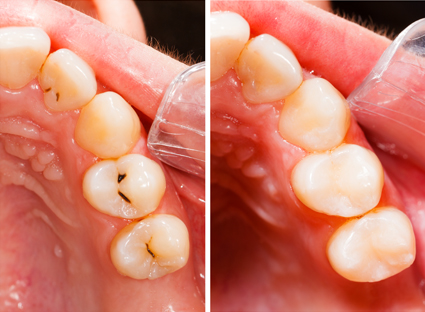FILLINGS
Occasionally your dentist may recommend a filling for your tooth. Teeth might need fillings for the following reasons:
- decay
- cracked teeth
- chipped teeth
- worn teeth from grinding
- old fillings breaking

Your dentist can determine whether or not your tooth needs a filling by:
- using a metal instrument to feel the softness of a tooth that’s been affected by decay, as a healthy tooth will be hard.
- X-rays: are very good at determining if there are any early signs of decay between two touching teeth which can be difficult to see with the naked eye. It can show the damage to the enamel and progress of the decay within a tooth.
- Cavity detecting dye: which can be rinsed over the tooth and will mark areas that have decay compared to healthy teeth.
What to expect during a filling

During an appointment for a filling, your dentist may give you a local anaesthetic injection to numb the area that is being worked on. Although having an injection may seem daunting, it generally makes the duration of the appointment a lot more comfortable for you. Decay is then removed from the tooth with a handpiece, which can make a lot of noise and spray water, you may also feel some vibration. Once all the decay has been removed and the cavity shaped, the filling material is placed in the tooth.
An LED light may be used to ‘cure’ the filling and set it so that it becomes strong. At this surgery, we only use tooth coloured or white fillings so you dont have to worry about metal fillings that do not blend in with the teeth.
After a filling is done, you should wait approximately two to four hours until the numbness has gone away before eating or drinking hot liquids, this is to prevent you accidentally biting your lips or tongue. Rarely, some people may have pain right after the numbness goes away, this can often be solved with some paracetamol. Secondly it may also be because the filling is ‘high’ and that it is hitting your opposing tooth before the other teeth touch. If this is the case, call the surgery as soon as possible and your dentist can adjust that filling for you.
Fillings can last many years, your dentist/OHT will check your fillings at your check up visits, and X-rays may be required if your dentist thinks that a filling is failing due to cracking or leaking or if there is decay under the filling. In this case it may be required to replace a filling. Occasionally if a filling is deemed quite large (taking up more than 50% of the tooth), your dentist may suggest a crown on that tooth as a crown can strengthen your teeth and prevent teeth from cracking.
